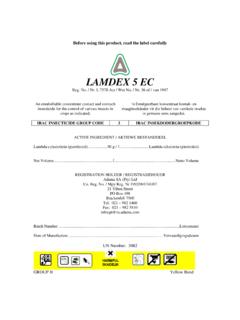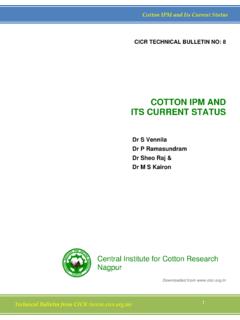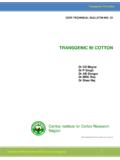Transcription of Contents and abstracts - iobc-wprs
1 III iobc-wprs Bulletin Vol. 80, 2012 Working Group Integrated Control in Protected Crops, Mediterranean Climate . Preceedings of the meeting at Catania, Sicily (Italy), 09 - 12 October, 2012. Edited by: Cristina Casta , Rosa Gabarra, Judit Arn , Luciana Tavella and Giovanna Tropea-Garzia. ISBN 978-92-9067-258-6 [VIII+ 344 pp.]. Preface .. I Contents .. III Key notes Prospects and challenges for biological pest control in protected crops in the Mediterranean Karel Bolckmans .. 3-9 Abstract: The Mediterranean is a major producer of protected crops. Especially during the past six years the uptake of biological control of pests has increased rapidly in the Mediterranean. The key challenges for growers are pesticide resistance management, residue management, regulatory requirements, risk management and cost-effectiveness. Suggestions are provided for continued research on improving biological control.
2 Biological and integrated protection in the Mediterranean greenhouse: is disease management the weak link? Philippe C. Nicot, Marc Bardin .. 11-17 Abstract: While biocontrol is commonly used for the protection of greenhouse crops against arthropods, continued reliance on chemical control against diseases is often considered as a hindrance to integrated protection. This paper presents a review of currently available biocontrol products and other alternatives to pesticides for use against plant diseases in the Mediterranean greenhouse. At least 12 biological active substances (micro-organism or plant extract) are commercially available for the control of soilborne pathogens and 14 against foliar diseases, in one country or more in the Mediterranean Basin. Future prospects and challenges are presented. Natural antagonists and insect control: a new perspective Francesco Pennacchio.
3 19-24 Abstract: The astonishing biodiversity of parasitic Hymenoptera and the large variety of strategies they use to colonize and exploit their insect hosts offer a wealth of molecular tools that can be profitably used for pest control. The virulence factors encoded by parasitic wasps and their associated symbionts are able to suppress the immune response of the host and to disrupt its physiological and reproductive processes. These molecules can directly target insect pests, and, by disrupting their immune response, they can also enhance the value of the ecological services offered by natural antagonists. The use of these natural bionsecticides is highly dependent on the development of targeted delivery strategies, which have to be designed to enhance both the efficacy and safety. The fast expansion of molecular technologies opens new avenues of research and makes possible the development of innovative pest control technologies, based on the use of parasitoid-derived molecules and/or on strategies mimicking their effects on insect hosts.
4 Integrating community ecology theories for optimizing IPM Nicolas Desneux .. 25 Abstract only IV Pest dynamics and surveys of their native natural enemies Survey of host plants and natural enemies of Drosophila suzukii in an area of strawberry production in Catalonia (northeast Spain) Judi Arn , Jordi Riudavets, Rosa Gabarra .. 29-34 Abstract: A new invasive pest, the fly Drosophila suzukii, is threatening several fruit crops in Europe. This pest is native to Asia and was first recorded in Europe in 2008. The first documented damage in our area occurred in 2011, mainly affecting cherries and strawberries. In this study, we aimed to determine which cultivated and non-cultivated plants host D. suzukii in an area in which heavy infestations on protected strawberry crops have occurred. Strawberries, raspberries, Arbutus unedo and Solanum luteum have been infested with D.
5 Suzukii. To our knowledge, the last two species had not previously been described as hosts of this fly. Evidences of the presence of the pest in unripe fruits were recorded. Some potential biological control agents in the local area were also identified. Four Hemiptera predator species were found in infested fruit samples: Orius laevigatus, Cardiastethus nazarenus, C. fasciventris and Dicyphus tamaninii. Further research is needed in the role of these natural enemies in the control of this pest. The cotton bollworm Helicoverpa armigera (Lepidoptera: Noctuidae) is it becoming a serious pest on pepper and tomato in Montenegro? Sanja Radonji , Snje ana Hrn i .. 35-38 Abstract: In the last few years, increases in the damage to pepper and tomato fruits caused by the cotton bollworm Helicoverpa armigera have been noticed in the southern part of Montenegro, the country s main pepper and tomato production area.
6 This includes the area around the city of Podgorica (Zeta and Bjelopavli i) and the Montenegro seacoast (Ulcinj) where these two cultures are grown both in greenhouses and outdoors. From July to September in 2010 and 2011, eight tomato and six pepper greenhouses in the Zeta and Bjelopavli i area were visually inspected. Two tomato greenhouses, one open-field tomato crop and one open-field pepper crop were visually inspected in 2011 in the Ulcinj area. As well as a visual inspection, the intensity of attack was also calculated for the pepper and tomato crops. The results of this study showed that larvae of H. armigera were found on pepper and tomato fruits in most of the inspected greenhouses and also on tomato fruits in the open field. More damaged pepper and tomato fruits were observed in 2011 than in 2010. A three-year survey of Tuta absoluta (Lepidoptera: Gelechiidae) population trends in Sardinian tomato greenhouses Mauro Nannini, Fabrizio Atzori, Michele Coinu, Riccardo Pisci, Francesco Sanna.
7 39-44 Abstract: Since 2008 Tuta absoluta has established in Sardinia (Italy) as the key pest of greenhouse tomatoes. With the aim of monitoring tomato borer population trends after its introduction in one of the most important fresh market tomato production areas of the island, from February 2009 to January 2012 we surveyed ten to fifteen commercial greenhouse crops per year. In each crop we assessed monthly the mean number of live T. absoluta larvae per tomato plant, the percentage of plants infested by larvae, the mortality and parasitism of 2nd-4th-instar larvae, and noted the treatment schedules. The highest levels of tomato borer infestation were observed in spring of 2009 (averaging 86 larvae/plant) and, to a lesser extent, in spring of 2010 and 2011 (55 and 41 larvae/plant, respectively). While pest density generally declined in summer, it increased moderately during autumn, not exceeding on average 8 larvae/plant, and was maintained in winter.
8 In most cases the highest levels of larval mortality were recorded between May and July. Except in a few cases, the contribution of larval parasitism to tomato borer mortality was poor. The insecticides most commonly used by growers for pest management were initially abamectin, azadirachtin and spinosad, but during the survey period the latter two products were gradually replaced by Bacillus thuringiensis-based insecticides and emamectin benzoate. V Tomato leafminer, Tuta absoluta, and insecticide resistance: a new challenge for control strategies Khalid Haddi, Madeleine Berger, Pablo Bielza, Dina Cifuentes, Linda M. Field, Kevin Gorman, Martin S. Williamson, Chris Bass, Carmelo Rapisarda .. 45-49 Abstract: The tomato leaf miner, Tuta absoluta (Lepidoptera), is a significant pest of tomatoes that has undergone a rapid expansion across Europe, North Africa and parts of Asia during the past six years.
9 One of the main means of controlling this pest is through the use of chemical insecticides. In the current study leaf-dip bioassays were used to determine the susceptibility of T. absoluta strains established from field collections to several insecticides. Additionally, the para-type sodium channel and acetylcholinestaerase gene from T. absoluta were cloned and sequenced. This revealed the presence of three kdr/super-kdr-type mutations (M918T, T929I and L1014F) in the sodium channel gene and mutation (A201S) in the acetylcholinesterase gene. To assess the prevalence of these mutations in 27 field strains from 12 countries high-throughput TaqMan diagnostic assays were developed. The results showed the presence of these mutations at high frequency in T. absoluta populations world-wide and suggests pyrethroids and organo-phosphates are likely to be ineffective for control.
10 These results also support the idea that the rapid expansion of this species over the last six years may be in part mediated by the resistance of this insect to chemical insecticides hence adding new challenges to control strategies for this pest. Promising native candidates for biological control of Tuta absoluta in Italy Chiara Ferracini, Barbara L. Ingegno, Marco Mosti, Paolo Navone, Luciana Tavella, Alberto Alma .. 51-55 Abstract: Tuta absoluta (Lepidoptera: Gelechiidae), native to central America, has been first reported in Europe in Spain in 2006 and in southern Italy in 2008, and by now it has become one of the major pests on tomato, its main host plant. In the two-year period 2009-2010, nine species of indigenous parasitoids emerged from tomato leaves infested by T. absoluta collected in horticultural areas of Liguria, Sardinia and Sicily (Italy). The most abundant species were Necremnus near artynes and N.







